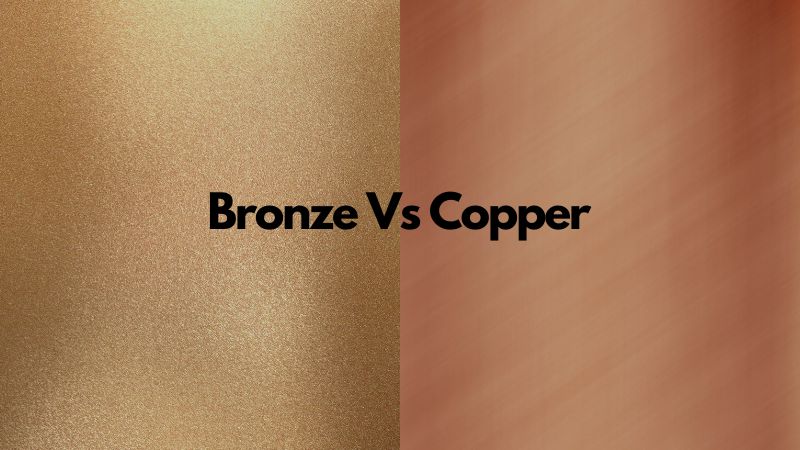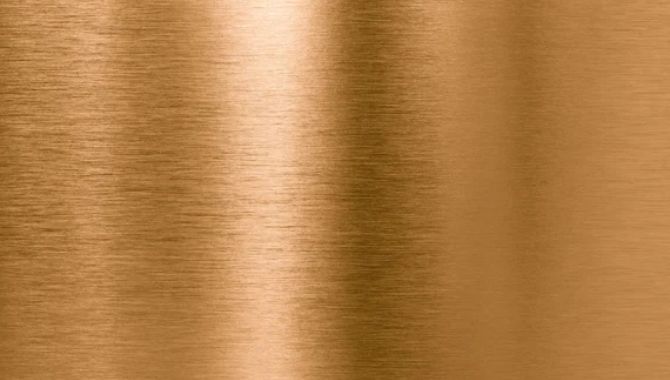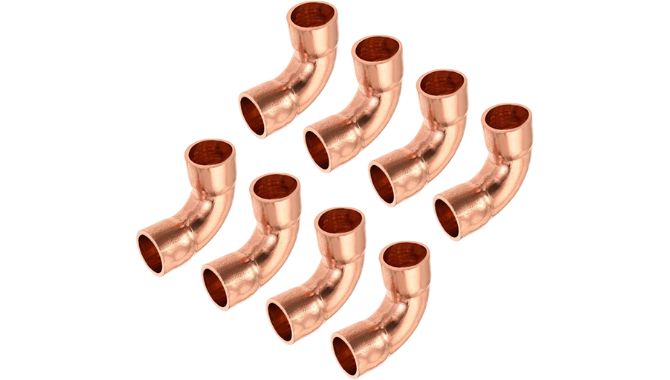
Distinguishing between bronze vs copper can be an uphill task for many. However, we hope to bring out a clear distinction between the metallurgical metals in this guide.
We will compare all the vital properties, applications, fabrication and formability properties. Let’s get started.
What is Bronze?

The discovery of bronze dates to around 3500 BC.
Look at the composition, both tin and copper form the main components, among other alloying elements.
Tin constitutes about 12 percent of bronze. However, copper takes the greatest chunk.
However, other alloying elements such as nickel, zinc, lead, arsenic, and phosphorus, among others can also be added.
Notably, the composition of bronze will significantly determine its appearance and other properties.
What is Copper?

Unlike bronze, copper freely exists in nature. Artifacts made from copper date back to around 5000 BC. During this time, its usage was in making tools, weapons, and decorations.
The chemical symbol of copper is Cu.
Key Alloying Elements in Bronze and Copper
These alloy grades are distinct and are mostly limited to specific applications.
For you to better understand the various grades, we have highlighted the main alloys in the below tables.
| Metal | Grade | Composition | Main Applications |
|
BRONZE | Alloy 932 (High-leaded) | 81 – 85% Copper 6 – 8 % Lead 1 – 4% Lead | Non-pressure applications such as the manufacture of washers and bushings. |
| Alloy 954 | 83% Copper 10 -11.5% Aluminum 3 – 5 % Iron1.5% Nickel0.3% Manganese | Manufacture of industrial and mounting equipment. | |
|
COPPER | Alloy 101 | Oxygen Free | High ductility and electrical conductivity applications |
| Alloy 110 | Electrolytic | High thermal & electrical conductivity applications. Excellent ductility and malleability | |
| Alloy 122 | Similar to Alloy 110 | Applications that require superior weldability and formability | |
| Alloy 145 | 0.7 % tellurium | Applications requiring high formability, machining. Of course this is alongside superior electrical and thermal conductivity. |
Aside from the two main grades highlighted above, bronze can also be classified as below:
| Type | Copper Composition | Other Alloying Elements |
| Commercial Bronze | 90% | 10% Zinc |
| Architectural Bronze | 57% | 40% Zinc 3% Lead |
| Plastic Bronze | 70% | About 30% Lead |
| Tin Bronze | 80 – 90% | 12 – 12.5% Tin 0.01 – 0.35% Phosphorus |
| Aluminum Bronze | 70 – 80% | 6 – 12% Aluminum < 6% Iron < 6% Nickel |
| Silicon Bronze | 70 – 80% | 20% Zinc 6% Silicon |
Price of Bronze Vs Copper
Alloying element composition determine the cost of each metal. A sophisticated alloy grade will attract a higher pricing compared to basic alloy grades.
Generally, copper tend to be costlier than bronze.
Metal Hardness Comparison: Bronze Vs Copper
When examining metal hardness, we use Brinell hardness testing. Of course, you will then assign the value according to specifications in the Brinell Hardness Scale.
From the Brinell Hardness Scale, copper has is less hard (35) compared to bronze (40-42).The alloying elements used in bronze significantly aid in boosting its hardness.
Chemical Elements in Copper Vs Bronze
As earlier mentioned, copper is pure compound. However, the chemical composition of copper may at times be altered. For example, there are copper alloys without oxygen while others have tellurium.
Apart from copper and tin, bronze has:
- Manganese
- Nickel
- Phosphorus
- Silicon
- Arsenic
- Antimony
- Lead
Applications of Bronze Vs Copper

Both bronze and copper have applications in the manufacturing industries. However, these applications differ due to the varying chemical composition of the two metals.
Bronze has all-round applications as below:
| Industry | Items |
| Music | Musical Instruments |
| Marine | Propellers, bearing, piping systems, etc. |
| Automobile | Springs, bushings, and bearings. |
| Construction | Wrenches, mallets, and hammers. |
| Woodwork | Bronze wool. |
| Sculpting | Casting bronze sculptures, utensils, jewelry |
Although, most applications of copper fall within the electrical industry, it also has other applications as highlighted in the table below:
| Industry | Items |
| Electronic Devices | Wires and cables IC, PCBs Heat sink, heat exchange, cathode ray tubes, electric motors, electromagnets |
| Architecture | Roofs, doors, spires, vaults, rain gutters, spires, flashings, domes |
| Energy | Solar panels, Turbine Engines |
| Investment | Metal bars for storage (Similar to Gold) |
| Health | Antimicrobial copper alloys |
| Marine | Lining For Ship parts |

Bronze Color Vs. Copper Color
Many copper alloys tend to have a reddish brown.
However, most bronze alloys have sepia color. That is they tend to resemble gold, but appear dull.
Copper Vs Bronze Corrosion Resistance
Copper is does undergo oxidation when exposed to the atmosphere. The resultant layer formed from the oxidation process is a mottled patina.
The patina layer (acting as a protective layer) makes bronze to exhibit an impressively high corrosion resistance.
Bronze is ideal for marine applications.
However, the two metals are not resistant to chlorine. Over time, chlorine breaks down copper.
When it comes to copper, the oxide layer makes it extremely resistant to most environmental conditions. Bronze has better corrosion resistance properties.
Electrical Conductivity of Bronze Vs Copper
The ability of a material to transfer electric energy is termed as electrical conductivity.
Copper has full electrical conductivity (100 percent). This property makes it the standard material internationally used in the manufacture of electrical components.
Bronze is not a very good electrical conductor. We can estimate its electrical conductivity to about 15% that of copper.
Thermal Conductivity: Copper Metal vs. Bronze Metal
Let’s compare the two metals:
- Copper – 223 BTU/hr-ft²-°F thermal conductivity
- Bronze – about 229 to 1440 BTU/hr-ft²-°F thermal conductivity
With the rise in temperature, the bronze thermal conductivity also increases.
Bronze Vs Copper Melting Point
From a general perspective, bronze has a lower melting point than copper.
Remember, the melting point varies depending on the alloying elements. As an estimate, the two metals melting points are as follows:
- Copper – about 1084 °C
- Bronze – between 315 °C and 1080 °C
Remember, the alloying elements act as impurity, lowering the melting point of bronze.
Machining Bronze Vs Machining Copper
Milling, turning, and stamping are some common examples of machining stress applied on either bronze or copper.
Copper has high machinability compared to bronze. When comparing bronze and copper, the latter is flexible.
Forming Copper Vs Bronze
Deductively, copper has higher formability than bronze. That is the reason copper is the preferred material in the production of micron-sized wires.
Welding Copper Compares Welding Bronze
You can weld copper and bronze separately or jointly.
The ideal welding techniques for bronze are either Metal Inter Gas (MIG) welding or Shielded Metal Arc Welding (SMAW).
On the other hand, TIG and MIG welding are perfect for joining copper.
Also, you can opt for either oxyacetylene or Manual Metal Arc (MMA) welding when repairing tough pitch copper.
Significantly, the weldability is determined by the grade of either the copper or bronze material.
Bronze Vs Copper: Strength
We cannot conclude the comparison of bronze and copper without looking at their strength.
We will look at three categories of strength:
- Yield strength – Strength(force) at which permanent deformation occurs on a material.
- Tensile Strength – Strength (force) at which a material fractures when being stretched.
- Shear Strength – Strength (force) at which the material’s internal structures slides against each other.
The table below is a summary of the strength property of the two.
| Metal | Yield Strength | Tensile Strength | Shear Strength |
| Bronze | 69.0 and 800 MPa 10000 and 116000 psi | 350 MPa to 635 MPa | 35000 psi to 47000 psi. |
| Copper | 33.3 MPa 4830 psi | 210 MPa | 25000 psi |
Comparing the two metals, bronze is stronger.
Quick FAQs
Does Bronze Rust?
Owing to its minimal iron content, bronze does not rust.
However, the copper component in bronze does undergo oxidation which results in a greenish outer layer.
Why do Copper and Bronze Turn Green?
Copper and bronze turn green due to oxidation.
As copper reacts with oxygen present in the atmosphere, it forms a greenish layer referred to as the mottled patina.
Is Copper Heavier than Bronze?
Copper is heavier than bronze. Copper has a density weight of 8930 kg/cu.m while bronze has a density weight ranging from 7400 to 8900 kg/cu.m (depending on the alloying elements)
How do you Differentiate Copper from Bronze?
Although both copper and bronze are reddish-brown, you can identify them using their color.
Below is a standard procedure to help you with the differentiation:
- Clean your copper and bronze sample. Preferably, using commercial cleaning products. This way you will be able to remove the greenish layer formed from oxidation.
- Once clean, expose your copper and bronze samples to sunlight. You can also use white light instead
- Now be keen. A discoloration with dull gold color will be bronze. The copper sample should have a pinkish-orange color.
Note: Both copper and bronze are reddish-brown, hence you need to be keen to notice the variation in the shades.
Conclusion
With the information in this guide, now you know when to choose bronze or copper for any application.
As discussed, the properties and distinctions give the two materials their merits and demerits.
More Resources:
Bronze vs. brass – source: KDM
Bronze – Source: Wikipedia
Bronze Fabrication – Source: KDM
Copper, Bronze, Brass (Metal Alloy Comparison) – Source: Sequoia
Brass vs Copper – Source: KDM
Bronze and Copper Colors – Source: eHow
Copper – Source: Science Direct
Copper Sheet Metal Fabrication – Source: KDM
Difference between Bronze, Copper & Brass – Source: Metal Supermarket
Difference Between Copper and Bronze – Source: The Difference




